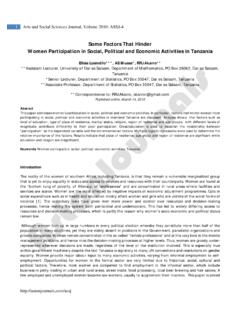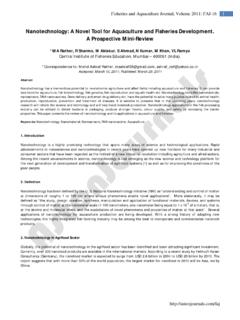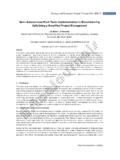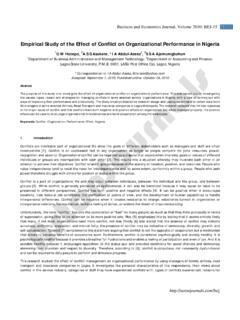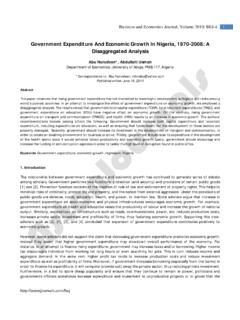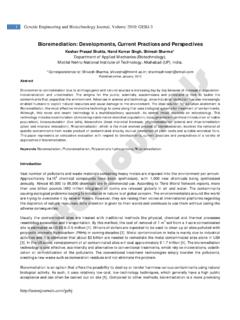Transcription of A Review on Biosurfactants: Fermentation, Current ...
1 Genetic Engineering and Biotechnology Journal, Vol. 2011: GEBJ-29, accepted version, Nov 7, 2011. (Manuscript type: Review ). A Review on Biosurfactants: Fermentation, Current Developments and Perspectives *BS Saharan1, RK Sahu2, D Sharma1. 1. Department of Microbiology Kurukshetra University, Kurukshetra Haryana 136 119, INDIA. 2. The Center For Autoimmune and Musculoskeletal Disease The Feinstein Institute for Medical Research 350 Community Drive Manhasset, New York 11030. *corresponding author Abstract Surfactants are compounds that reduce the surface tension of a liquid, the interfacial tension between two liquids, or that between a liquid and a solid. Surfactants are characteristically organic compounds containing both hydrophobic groups (their tails) and hydrophilic groups (their heads). Therefore, a surfactant molecule contains both a water insoluble (and oil soluble component) and a water soluble component. Biosurfactnats encompass the properties of dropping surface tension, stabilizing emulsions, promoting foaming and are usually non-toxic and biodegradable.
2 Interest in microbial surfactants has been progressively escalating in recent years due to their diversity, environmentally friendly nature, possibility of large-scale production, selectivity, performance under intense circumstances and their impending applications in environmental fortification. These molecules have a potential to be used in a variety of industries like cosmetics, pharmaceuticals, humectants, food preservatives and detergents. Presently the production of biosurfactants is highly expensive due to the use of synthetic culture media. Genetic Engineering and Biotechnology Journal, Vol. 2011: GEBJ-29, accepted version, Nov 7, 2011. (Manuscript type: Review ). Therefore greater emphasis is being laid on procurement of various cheap agro-industrial substrates including vegetable oils, distillery and dairy wastes, soya molasses, animal fat, waste and starchy waste as raw materials. These wastes can be used as substrates for large-scale production of biosurfactants with advanced technology which is the matter of future research.
3 This Review article represents an exhaustive evaluation of the raw materials, with respect to their commercial production, fermentation mechanisms, Current developments and future perspectives of a variety of approaches of biosurfactant production. * Corresponding author. Tel.: +91-9416545332. E-mail address: (Baljeet Singh). Keywords Biosurfactants, Bioemulsifiers, Fermentation, Commercial Production, Agro-Industrial wastes 1. Introduction Surfactants are amphiphilic surface active agents possessing both hydrophilic and hydrophobic moieties that reduce surface and interfacial tensions by accumulating at the interface between two immiscible fluids like oil and water, signifying that surfactants moreover assist the solubility of polar compounds in organic solvents. They are of synthetic or biological origin. Due to their interesting properties such as lower toxicity, higher degree of biodegradability, higher foaming capacity and optimal activity at extreme conditions of temperatures, pH levels and salinity, these have been increasingly attracting Genetic Engineering and Biotechnology Journal, Vol.
4 2011: GEBJ-29, accepted version, Nov 7, 2011. (Manuscript type: Review ). the attention of the scientific and industrial community. Biosurfactants are a group of structurally diverse molecules produced by different microorganisms classified mainly by their chemical structure and microbial origin. Structurally, they contain a hydrophilic moiety, comprising an acid, peptide cations, or anions, mono-, di- or polysaccharides and a hydrophobic moiety of unsaturated or saturated hydrocarbon chains or fatty acids. They are mainly classified into two classes: low-molecular weight surface active agents called biosurfactants (lipopeptide, glycolipids) and bioemulsifiers (high molecular weight surface active agents). They efficiently reduce surface and interfacial tensions [1, 2]. Biosurfactants are further divided into six classes: hydroxylated and cross linked fatty acids (mycolic acids), glycolipids, lipopolysaccharides, lipoproteins-lipopeptides, phospholipids and the complete cell surface itself.
5 Biosurfactants have many environmental applications such as bioremediation and dispersion of oil spills, enhanced oil recovery and transfer of crude oil. Other potential applications of biosurfactants relate to food, cosmetic, health care industries and cleaning toxic chemicals of industrial and agricultural origin. Objectives of this Review To assess the Current perspectives of biosurfactant production using inexpensive and easily available agro-industrial substrates. To provide an insight into the role of various developed processes like fermentation, optimization, product recovery, substrate utilization and major controls that may be used for their management in production of cost effective microbial surfactants. Genetic Engineering and Biotechnology Journal, Vol. 2011: GEBJ-29, accepted version, Nov 7, 2011. (Manuscript type: Review ). To highlight the limitations and challenges related to the various developed processes of biosurfactant fermentation.
6 2. Microorganisms producing biosurfactants Biosurfactants produced by a variety of microorganisms mainly bacteria, fungi and yeasts are diverse in chemical composition (Table-1) and their nature and the amount depend on the type of microorganism producing a particular biosurfactant. Many microorganisms for industrial utilization for waste products have been isolated from contaminated soils, effluents and waste water sources. Thus, these have an ability to grow on substrates considered potentially noxious for other non-producing microorganisms. Table-1: List of biosurfactant producing organisms. Sr. No. Biosurfactant Microorganism(s) Current economic Reference(s). importance 1. Cellobiose lipids Ustilago maydis Antifungal Compounds [3]. 2. Serrawettin Serratia marcescens Emulsification of [4]. hydrocarbons 3. Polyol lipids Rhodotorula glutinis, R. graminis Anti-proliferative [5]. activity 4. Trehalose lipids Rhodococcus erythropolis, Dissolution of [6].
7 Arthrobacter sp., Nocardia hydrocarbons erythropolis, Corynebacterium sp., Mycobacterium sp 5. Ornithine lipids Pseudomonas sp., Thiobacillus Bio-emulsifiers [7]. thiooxidans, Agrobacterium sp. 6. Viscosin Pseudomonas fluorescens, Surface active [8]. Leuconostoc mesenteriods lipopeptides 7. Rhamnolipids Pseudomonas aeruginosa, Bioremediation, [9]. Pseudomonas chlororaphis,Serratia Antimicrobial and rubidea biocontrol properties 8. Carbohydrate-lipid , Debaryomyces Bio-emulsifiers [10]. polmorphus 9. Protein PA Bio-emulsifiers [11]. 10. Diglycosyl Lactobacillus fermentum Bio-remediation [12]. diglycerides 11. Whole cell Cyanobacteria Bio-flocculent [13]. 12. Fatty acids /neutral Clavibacter Bio-emulsifiers [14]. lipids michiganensis subsp. insidiosus 13. Sophorolipids Candida bombicola, C. antartica, Antimicrobial, Antiviral, [15]. Torulopsis petrophilum C. botistae, Spermicidal C. apicola, C. riodocensis, C. stellata, Genetic Engineering and Biotechnology Journal, Vol.
8 2011: GEBJ-29, accepted version, Nov 7, 2011. (Manuscript type: Review ). C. bogoriensis 14. Liposan C. tropicalis Bio-emulsan [16]. 15. Monnosylerythritol , Kurtzmanomyces sp., Antifungal compounds [17]. lipids Pseudozyma siamensis 16. Surfactin/Iturin B. subtilis, B. amyloliquefaciens Antimicrobial [18]. properties 17. Subtilisin B. subtilis Antimicrobial [19]. properties 18. Aminoacids lipids Bacillus sp. Antimicrobial [20]. properties 19. Lichenysin Bacillus licheniformis, B. subtilis Microbially enhanced [21]. oil recovery (MEOR). 20. Peptide lipids B. licheniformis Antimicrobial [22]. properties 21. Phospholipids Acinetobacter sp. Bioremediation [23]. 22. Vesicles & fimbriae Acinetobacter calcoaceticus, P. Bioremediation [7]. marginilis, P. Maltophila 23. Emulsan A. calcoaceticus Microbially enhanced [24]. oil recovery (MEOR). 24. Alasan A. radioresistens Biodegradation of [25]. polyaromatic compounds 3. Economic factors of Biosurfactant production To overcome the expensive cost constraints associated with biosurfactant production, two basic strategies are generally adopted worldwide to make it cost-effective: (i) the use of inexpensive and waste substrates for the formulation of fermentation media which lower the initial raw material costs involved in the process; (ii) development of efficient and successfully optimized bioprocesses, including optimization of the culture conditions and cost-effective recovery processes for maximum biosurfactant production and recovery.
9 As millions of tons of hazardous and non-hazardous wastes are generated each year throughout the world, a great need exists for their proper management and utilization. The residues from tropical agronomic crops such as cassava (peels), soybeen (hull) [26], sugar beet [27], sweet potato (peel and stalks), potato (peel and stalks), sweet sorghum [28], rice and wheat [29] bran and straw); hull soy, corn and rice; bagasse of sugarcane and cassava;. Genetic Engineering and Biotechnology Journal, Vol. 2011: GEBJ-29, accepted version, Nov 7, 2011. (Manuscript type: Review ). residues from the coffee processing industry such as coffee pulp, coffee husks, spent coffee grounds; residues of the fruit processing industries such as pomace and grape, waste from pineapple and carrot processing, banana waste; waste from oil processing mills such as coconut cake, soybean cake, peanut cake, canola meal and palm oil mill waste; saw dust, corn cobs, carob pods, tea waste, chicory roots etc.
10 Have been reported as substrates for biosurfactant production [30]. Additional substrates used for biosurfactant production include water-miscible wastes, molasses, whey milk or distillery wastes. [28].The various substrates previously reported for biosurfactants production are listed (Table-2) with their advantages. Table 2: Substrate for Microbial surface active agents and their advantages Source Substrate part End product (s) Reference(s). Cassava Flour Biosurfactant [31]. Soybean oil Seeds Rhamnolipid [26]. Sugar beet Peels Biosurfactant [27]. Sweet Potato Peels Biosurfactant [28]. Sweet Sorghum Peels Biosurfactant [28]. Rice and wheat bran Stem Husk Biosurfactant [32]. Sugarcane Bagasse Stem Husk Biosurfactant [29]. Cashew Apple juice Pomace Biosurfactant [33]. Dairy Whey Whey Bioemulsifiers [34]. 4. Substrates for commercial microbial production Despite possessing many industrially attractive properties and advantages compared with Genetic Engineering and Biotechnology Journal, Vol.
